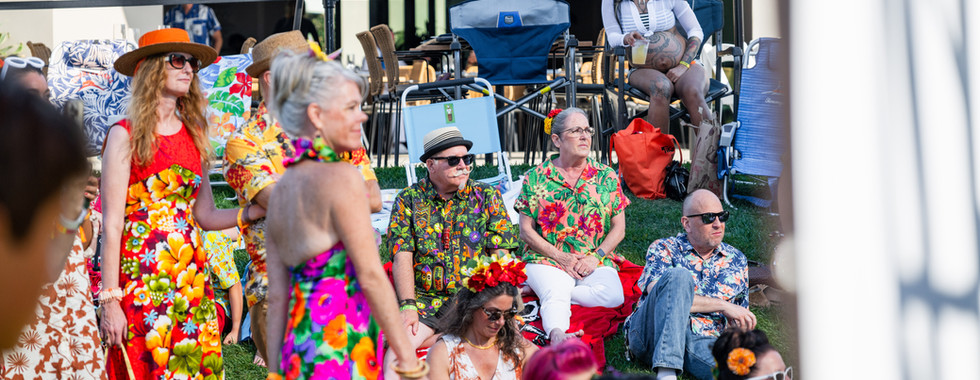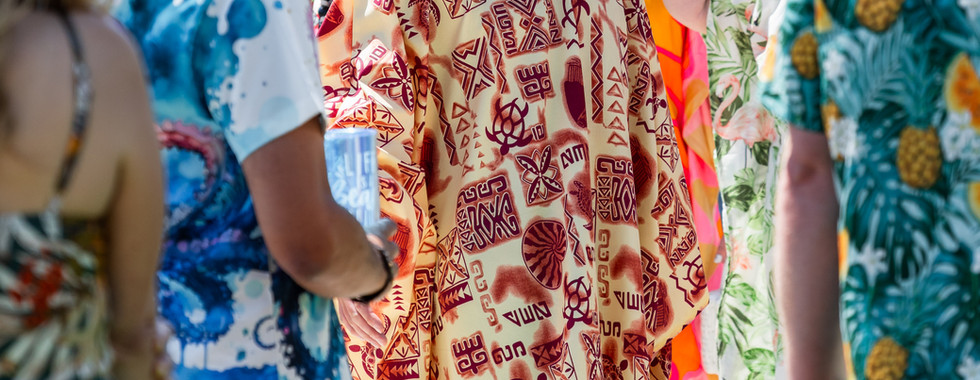Tiki Oasis: San Diego 2024
- Alvinita Gonzales

- Aug 10, 2024
- 4 min read
Updated: Jul 24

San Diego, CA — Tiki Oasis 2024:
As a proud Latina & Indigenous attendee, this was my second year attending Tiki Oasis, and while I came for the music, vintage fashion, and escapist nostalgia, I left with something deeper... a renewed appreciation for both celebration and accountability. Held in San Diego from August 1–4, Tiki Oasis 2024 brought thousands of us together to indulge in the vibrant visual world of mid-century tiki—a world that’s both playful and, if we’re honest, historically complicated.
As Tiki Oasis returned this summer as one of the largest and longest-running festivals dedicated to mid-century tiki culture, exotica music, vintage fashion, and all things Polynesian Pop. From August 1–4, tiki enthusiasts from around the world will gather at the Town and Country Resort for a weekend filled with art, cocktails, surf rock, burlesque, rum tastings, vintage shopping, poolside lounging, and educational symposiums. The event continues to grow in popularity while also evolving to meet the conversations of today, including a deeper acknowledgment of the Indigenous cultures that inspired the aesthetic it celebrates.

Theme:
This year’s theme, “Tropic of Technicolor,” brings vibrant visual nostalgia to the forefront—highlighting the explosion of color and kitsch in 1950s and ’60s pop culture. Expect swaying palms, tiki mugs, ukulele jams, and high-octane dance floors. The event lineup features headliners in surf rock and lounge music, mixology classes led by award-winning bartenders, and panels exploring the influence of Hollywood, postwar escapism, and design on the tiki revival movement.
Beyond the party atmosphere, Tiki Oasis 2024 offers educational seminars, including deep dives into cocktail history, the evolution of tiki bars, and the hidden legacies of the cultures these bars draw from. Scholars, artists, and cultural practitioners are invited to lead discussions, and for many attendees, these spaces are key to expanding the event’s cultural context.

A Conversation Around Cultural Appreciation vs. Appropriation
As tiki culture continues to be reevaluated, especially in light of indigenous rights and cultural sovereignty, many are asking: Who gets to tell Polynesian stories?
Much of what Americans recognize as “tiki” was shaped by post-WWII escapist fantasies—rooted more in Hollywood studio sets and Don the Beachcomber’s mashup aesthetic than in the authentic traditions of Pacific Island cultures. The original tiki bars commercialized motifs from Hawai‘i, Tahiti, New Zealand, and other Pacific Islands, often without understanding their sacred meanings or consulting the communities they portrayed.
Critics have long pointed out that tiki’s use of imagery such as carved idols, traditional dress, and sacred symbols can perpetuate stereotypes or erase real, lived cultures. At the same time, some Native Pacific Islanders have entered the conversation — not just to critique but to reclaim space and nuance within these retro spaces.
This year, Tiki Oasis continues its effort to offer Indigenous voices a platform, inviting Pacific Islander artists, chefs, musicians, and educators to contribute authentically. Past years have featured Polynesian dance troupes, carving demonstrations by Māori and Hawaiian artists, and panels led by scholars of Indigenous Pacific cultures. The hope is not to erase tiki’s roots in Americana but to engage more responsibly with the cultures it has drawn from and celebrating them on their own terms.
Supporting Indigenous Artists and Communities
An encouraging sign of growth is the presence of vendors and artists of Native Hawaiian, Chamorro, and other Oceanic backgrounds at the marketplace, where hand-carved art, traditional textiles, and storytelling are shared alongside the kitschier wares. A portion of proceeds from select events is also slated to benefit cultural preservation projects in Oceania.
Attendees are encouraged to explore beyond aesthetics and learn about the histories and living cultures behind the “tiki” mask. This includes being mindful about attire, asking questions with curiosity and humility, and listening when Indigenous voices speak on their own experiences.

From the Latina/o Margins to the Mix
As someone from the Latino community, I see parallels—and tensions. Many of us grew up with our own deep-rooted traditions of music, storytelling, spiritual symbolism, and color. I noticed how Latin rhythms infused the event: cumbia and mambo spinning in DJ sets, Latinx bartenders bringing mezcal into tiki drink menus, and vintage Latina pinups being embraced in the fashion scene.
Still, our cultural stories were not always centered. Tiki culture tends to flatten multiple identities into a single aesthetic. So I ask: where are the voices of Caribbean and Mesoamerican Indigenous peoples who also influenced tropical aesthetics and music? Where are the Afro-Latinx stories tied to rum and sugarcane history? The presence of Latin America is felt, but often unspoken or unnamed.
This year, I met other Latino creatives who are slowly reshaping what tiki can be: not just an escape, but an inclusive, respectful celebration of all the cultures that have historically been tropicalized or exoticized. We talked about owning our stories, respecting our elders, and honoring the complex histories tied to land, colonization, and diaspora.

A Space to Evolve
Tiki Oasis isn’t perfect, but it’s evolving. The marketplace this year included more Indigenous and Latinx vendors than ever before. Some symposiums focused on decolonizing design and reimagining hospitality spaces through a more ethical lens. There was even a conversation about whether “tiki” as a term still serves the community, or if a new term is needed.
To me, this evolution matters. As a Latino, I want to be part of the party, but I also want the party to see us fully. Not just as guests or performers, but as cultural contributors with our own rich, complex histories.

Conclusion
Tiki Oasis 2024 was fun, undeniably. But the most impactful part wasn’t just the mai tais or the music. It was the sense that we’re in a moment of transformation: where celebration and consciousness can coexist.
For anyone attending next year, I say this: Come for the fun, but stay for the conversations. Ask questions. Support Indigenous and Latinx makers. And remember that behind every pattern, song, or cocktail name, there’s a deeper story waiting to be honored.
Tiki Oasis Website and More Information:
Tiki Oasis Website: tikioasis.com Tiki Oasis Instagram: @tikioasis NCAIED Facebook: facebook.com/tikioasis
NCAIED YouTube: @TikiOasisTV
Credits
Photographer: Alvinita Gonzales | @photographsbyag
































































































































































Comments